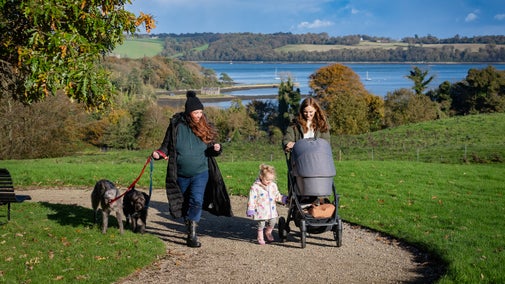Polperro to Looe coast walk
Cornwall
The walk passes an early Christian holy site and the ruins of a medieval chapel built on it. The chapel was built after a number of pilgrims drowned trying to reach its predecessor on Looe Island. This part of Cornwall had lively trading links with the Mediterranean even in prehistoric times, and it is said that Jesus visited Looe, accompanying his uncle, Phoenician tin trader Joseph of Arimathea.
Near to
Lantic BayStart point
Crumplehorn pub car park, Polperro, Looe, Cornwall PL13 2RJ. Grid ref: SX204515Trail information
Take care with cliffs
Be aware of cliff edges and unstable cliffs – keep children supervised.
More near here
Covington walk in the Fowey estuary
A circular walk around the Cornish harbour town of Fowey on this National Trust trail taking in heritage highlights and views across the estuary. It's the perfect place for a stroll with plenty of places to stop for a picnic too.

Polruan to Polperro rollercoaster walk
A strenuous walk high above turquoise seas and white sandy beaches, and through prime fishing and smuggling territory.

Hendersick and Talland Bay Loop
This circular walking trail takes you along the South West Coast Path, with views over Looe Island and the South East Cornwall coast.

Lantivet Bay circular walk
Discover a landscape with a rich fishing and smuggling heritage on this circular walk around Lantivet and Lantic bays in Cornwall.

Get in touch
Our partners

We’ve partnered with Cotswold Outdoor to help everyone make the most of their time outdoors in the places we care for.
You might also be interested in
Walking
Explore some of the finest landscapes in our care on coastal paths, accessible trails, woodland walks and everything in between. Find the best places to walk near you.

Follow the Countryside Code
Help to look after National Trust places by observing a few simple guidelines during your visit and following the Countryside Code.

How to stay warm on a winter walk
Don’t let the cold weather put you off exploring winter landscapes and getting out into the crisp air. Keep warm on your next winter walk with these top tips and kit ideas.

Top tips for coastal walks
Get safety tips for walking by the coast, including the essential clothing and equipment to take with you and what to do before you set out.

Staying safe at National Trust places
The special places in National Trust care sometimes come with a few risks for visitors, be it coastline or countryside. Find out how to keep safe throughout your visits.

Family-friendly walks
Take a family-friendly walk along these trails suitable for pushchairs and children. On the way, you can go wild in natural play areas and compete in woodland den building.

Cotswold Outdoor: our exclusive walking partner
Learn about the National Trust’s ongoing partnership with Cotswold Outdoor. Find out how they help us care for precious places and the exclusive discount available for National Trust supporters.

Walking in Cornwall
From strolls that reward you with stunning views of the South West coast to gentle inland meanders, these are some of the best walks in Cornwall.

